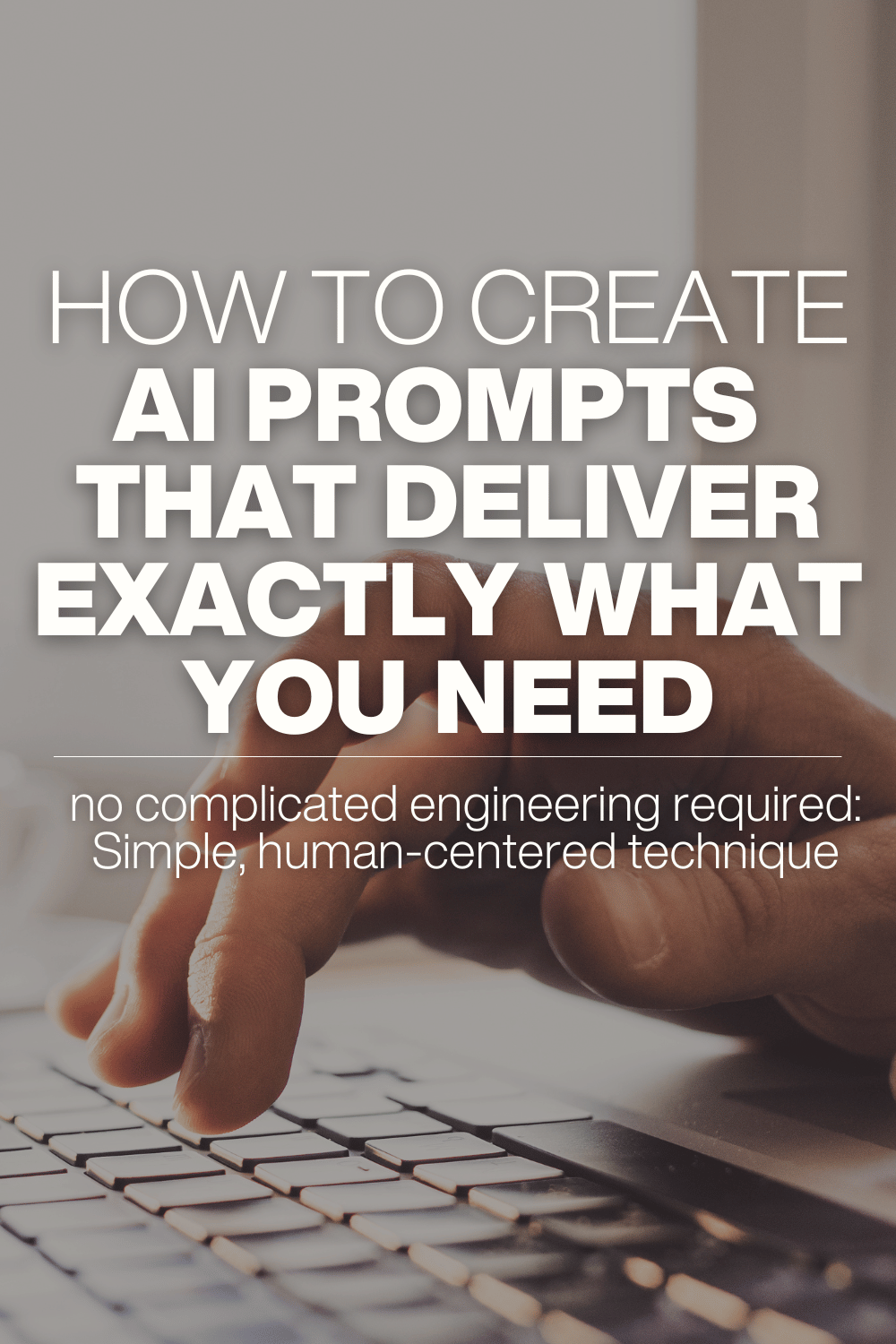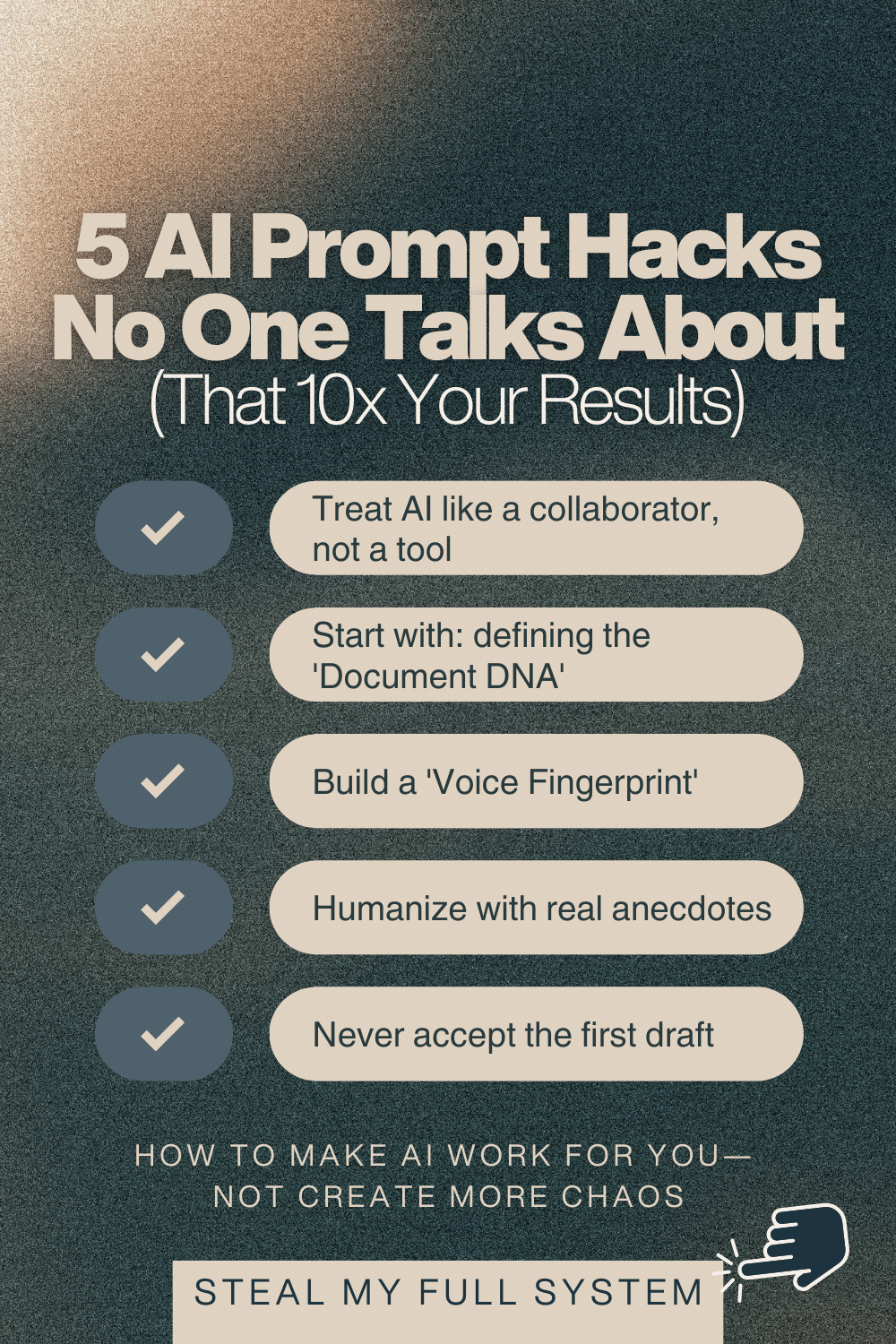
I watched a founder spend four hours crafting a single AI prompt only to get a generic, lifeless response she could have written herself in 10 minutes.
People are approaching AI all wrong. They're treating prompts either with zero creativity and specificity… or, on the opposite end of the spectrum, like complicated programming languages rather than conversations with a particularly helpful (but sometimes quirky) collaborator.
It’s not rocket science… but it does take some work. Even Forbes says there are 9 crucial components of an excellent prompt.
And it’s understanding that you have to insert personality, detail, and guidance. This is not a place for standardization.
After thousands of interactions and helping teams transform their AI workflows, I've distilled my approach into practical techniques anyone can use.
Here's how I create prompts that deliver exactly what I need:
The Mindset Shift: Stop "Prompting" and Start Directing
Instead, think of yourself as a director working with a talented but inexperienced writer who:
- Has read everything but hasn't lived much
- Needs clear guidance rather than vague requests
- Benefits from context and examples
- Performs best when you explain your why, not just your what
When I sit down to create content with AI, I don't write prompts—I have conversations that follow a specific pattern:
My 5-Part Framework for High-Impact Prompts
1. Define the Document DNA
I always start by establishing what we're creating together:
"I want to create [TYPE OF CONTENT] about [TOPIC] for [AUDIENCE]. This piece should [PRIMARY PURPOSE]."
For example:
- "I want to create a persuasive sales email about our new productivity software for busy executives. This piece should address their time scarcity and demonstrate immediate ROI."
- "I want to create a step-by-step tutorial about optimizing LinkedIn profiles for job seekers in their 50s. This piece should feel approachable and non-technical."
2. Establish the Voice Fingerprint
Generic content sounds generic. To make outputs match my voice (or any desired voice), I use this approach:
"Write this in a voice that is [3-5 VOICE CHARACTERISTICS] and avoids [1-2 THINGS TO AVOID]."
For my own content:
- "Write this in a voice that is conversational, occasionally provocative, warm, and practical—like we're having coffee together. Avoid corporate jargon and unnecessarily complex explanations. Remember you’re writing as me, Marissa Brassfield, "
For client work, I'll often:
- Send samples of their existing content and say "Match this tone and style"
- Identify a public figure with a similar communication style and reference them
- Provide 3-5 representative sentences that capture the essence of their voice
3. Structure for Impact
Even the most sophisticated AI can ramble without direction.
I always outline the structure I want:
"Structure this as:
1. [OPENING APPROACH]
2. [WHAT TO COVER NEXT]
3. [ADDITIONAL SECTIONS WITH PURPOSE]
4. [HOW TO CONCLUDE]"
For example:
- "Structure this as: 1) A surprising statistic about productivity waste, 2) Three common mistakes people make with their to-do lists, 3) My alternative approach with specific examples, 4) A simple challenge for tomorrow morning."
4. Inject Human Elements
The biggest giveaway of AI-generated content isn't technical errors—it's the absence of genuine human elements:
"Include [SPECIFIC HUMAN ELEMENTS] that will resonate with the audience."
Elements I regularly include:
- "Reference a specific challenge I encountered with a client last month"
- "Include a personal anecdote about experimenting with this technique"
- "Acknowledge a common fear or objection people have about this topic"
- "Add a touch of self-deprecating humor about the learning curve"
5. Create Revision Loops
The secret weapon in my process? I never accept the first output. Ever.
I also don’t go in for a hands-on edit until I’ve prompted 1 or 2 rounds of edits with the LLM.
"This is close, but let's improve it by [SPECIFIC CHANGES]. Also, [ADDITIONAL DIRECTION]."
This feedback loop is where the magic happens. Examples:
- "This is too formal. Shorten the sentences by 30% and add more conversational transitions."
- "The opening doesn't grab attention. Start with something more provocative and unexpected."
- "This needs more specific examples. Replace the general statements in the third paragraph with a real-world scenario."
Real-World Example: Transforming Bland into Brilliant
Let me show you the difference between a basic prompt and my approach:
Basic Prompt: "Write a blog post about employee engagement strategies."
My Approach: "I want to create a provocative blog post about employee engagement for visionary business leaders who are skeptical of 'culture initiatives.' This piece should challenge conventional thinking while providing actionable alternatives that address root-cause issues with grace and tact.
Write this in a voice that's direct, evidence-based, and occasionally irreverent, similar to how I've communicated in my previous posts. Avoid corporate buzzwords and fluffy recommendations. No generic AI phrases (like “seasoned” for experienced), or overuse of the em dash.
Structure this as:
- A pattern-interrupt opening that challenges a common assumption about engagement
- Three specific engagement approaches that don't require ping pong tables or free lunch
- A case study snippet from my client work (anonymized)
- Clear next steps that can be implemented tomorrow
Include a personal anecdote about my own journey from engagement skeptic to advocate, and acknowledge the legitimate business concerns about ROI on culture investments."
Your Turn: Practical Next Steps
Creating effective prompts is a skill you develop through practice. Start by:
- Identifying your core communication patterns - Record yourself talking about a topic you're passionate about, then transcribe and analyze your natural speech patterns
- Building a personal style guide - Document the characteristics that make your communication distinctive
- Creating "voice calibration" examples - Write 3-5 sentences that perfectly capture your tone to use in prompts
- Practicing the revision loop - Don't settle for "good enough" first drafts
The most effective AI users aren't those with the most technical knowledge—they're the ones who understand how to clearly communicate what they want while providing the context and direction that AI systems need to shine.
What's your biggest challenge when working with AI?
Share in the comments below, or message me on Instagram or LinkedIn and I'll help troubleshoot your specific situation.

P.S. If you’re looking for more ideas on how to use AI in your daily life, from work to wellness, check out my interview with Kat (episode 4) on The Well Done Pod (spotify or apple podcasts). You don’t want to miss it!
Get fresh takes on work-life alignment, leadership, and optimizing quality of life.


Member discussion